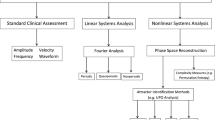Abstract
Three-dimensional signal analysis can be applied to eye movements called nystagmus in order to study otoneurological patients suffering from vertigo and other balance problems. We developed an analysis and modeling algorithm for three-dimensional nystagmus measured by a video-oculography system. We were also interested in verifying an otoneurological hands-on convention called Ewald’s first law in a strict physiological sense in vestibular patients. We recorded nystagmus from 42 patients all suffering from vertigo or dizziness. The underlying pathology was unilateral in 39 patients, bilateral in one patient, and central in two patients. Video-oculography was used to record three-dimensional nystagmus to separately produce horizontal, vertical, and torsional signals for each eye. On the basis of signal analysis techniques and straightforward vector calculus, we were able to recognize slow phases of nystagmus to compute their angular velocities to estimate from which part of the inner ear the disorder originated. We found that for all 42 patients the plane of one of the two horizontal semicircular canals was the closest. We were able to quantitatively estimate the influence of different semicircular canals, and, despite the pathology, horizontal canals seemed to be predominant in driving the nystagmus. The signal analysis and modeling algorithm developed is effective in studying otoneurological problems registered with nystagmus and opens new insights in three-dimensional nystagmography. Our results strongly support Ewald’s first law.





Similar content being viewed by others
References
Blanks, R. H., I. S. Curthoys, and C. H. Markham. Planar relationships of the semicircular canals in man. Acta Otolaryngol. 80:185–196, 1975.
Böhmer, A., D. Strauman, and M. Fetter. Three-dimensional analysis of spontaneous nystagmus in peripheral vestibular lesions. Ann. Otol. Rhinol. Laryngol. 106:61–68, 1997.
Cremer, P. D., A. A. Migliaccio, D. V. Pohl, I. S. Curthoys, L. Davies, R. A. Yavor, and G. M. Halmagyi. Posterior semicircular canal nystagmus is conjugate and its axis is parallel to that of the canal. Neurology 54:2016–2020, 2000.
Cremer, P. D., L. B. Minor, J. P. Carey, and C. C. Della Santina. Eye movements in patients with superior canal dehiscence syndrome align with the abnormal canal. Neurology 55:1833–1846, 2000.
Curthoys, I. S., R. H. I. Blanks, and C. H. Markham. Semicircular canal functional anatomy in cat, guinea pig and man. Acta Otolaryngol. 83:258–265, 1997.
Della Santina, C. C., V. Potyagaylo, A. A. Migliaccio, L. B. Minor, and J. P. Carey. Orientation of human semicircular canals measured by three-dimensional multiplanar CT reconstruction. J. Assoc. Res. Otolaryngol. 6:191–206, 2005.
Fetter, M., and J. Dichgans. Vestibular neuritis spares the inferior division of vestibular nerve. Brain 119:755–763, 1996.
Furman, J., and S. L. Whitney (eds.). Otoneurology. Neurologic Clinics (3rd ed.), Vol. 23. Philadelphia: Saunders, 2005.
Haslwanter, T. Mathematics of three-dimensional eye rotations. Vis. Res. 35(12):1727–1739, 1995.
Imai, T., K. Sekine, K. Hattori, N. Takeda, I. Koizuka, K. Nakamae, K. Miura, H. Fujioka, and T. Kubo. Comparing the accuracy of video-oculography and scleral search coil system in human eye movement analysis. Auris Nasus Larynx 32:3–9, 2005.
Imai, T., N. Takeda, M. Ito, K. Sekine, G. Sato, Y. Midoh, K. Nakamae, and T. Kubo. 3D analysis of benign positional nystagmus due to cupulolithiasis in posterior semicircular canal. Acta Otolaryngol. 129(10):1044–1049, 2009.
Juhola, M. Computer procedures for verification of nystagmus eye movements in pattern recognition of nystagmus signals. Innov. Technol. Biol. Med. 12(3):364–374, 1991.
Juhola, M., H. Aalto, and T. Hirvonen. Using results of eye movement signal analysis in the neural network recognition of otoneurological patients. Comput. Methods Progr. Biomed. 86:216–226, 2007.
Juhola, M., H. Aalto, and T. Hirvonen. On signal analysis of three-dimensional nystagmus. In: Proceedings of Medical Informatics Europe 2009, Sarajevo Bosnia and Herzegovina: IOS Press, 2009, pp. 846–850.
Juhola, M., V. Jäntti, and I. Pyykkö. Effect of sampling frequencies on computation of the maximum velocity of saccadic eye movements. Biol. Cybern. 53:67–72, 1985.
Juhola, M., and I. Pyykkö. Effect of sampling frequencies on the velocity of slow and fast phases of nystagmus. Int. J. Biomed. Comput. 20:252–263, 1987.
Tweed, D., W. Cadera, and T. Vilis. Computing three-dimensional eye position quaternions and eye velocity from search coil signals. Vis. Res. 30(1):97–110, 1990.
Tweed, D., and T. Vilis. Geometric relations of eye position and velocity vectors during saccades. Vis. Res. 30(1):111–127, 1990.
van der Geest, J. N., and M. A. Frens. Recording eye movements with video-oculography and scleral search coils: a direct comparison of two methods. J. Neurosci. Methods 114:185–195, 2002.
Yagi, T., and Y. Koizumi. 3D analysis of cough-induced nystagmus in a patient with superior semicircular canal dehiscence. Auris Nasus Larynx 36:590–593, 2009.
Author information
Authors and Affiliations
Corresponding author
Additional information
Associate Editor Berj L. Bardakjian oversaw the review of this article.
Rights and permissions
About this article
Cite this article
Juhola, M., Aalto, H., Jutila, T. et al. Signal Analysis of Three-dimensional Nystagmus for Otoneurological Investigations. Ann Biomed Eng 39, 973–982 (2011). https://doi.org/10.1007/s10439-010-0211-3
Received:
Accepted:
Published:
Issue Date:
DOI: https://doi.org/10.1007/s10439-010-0211-3




